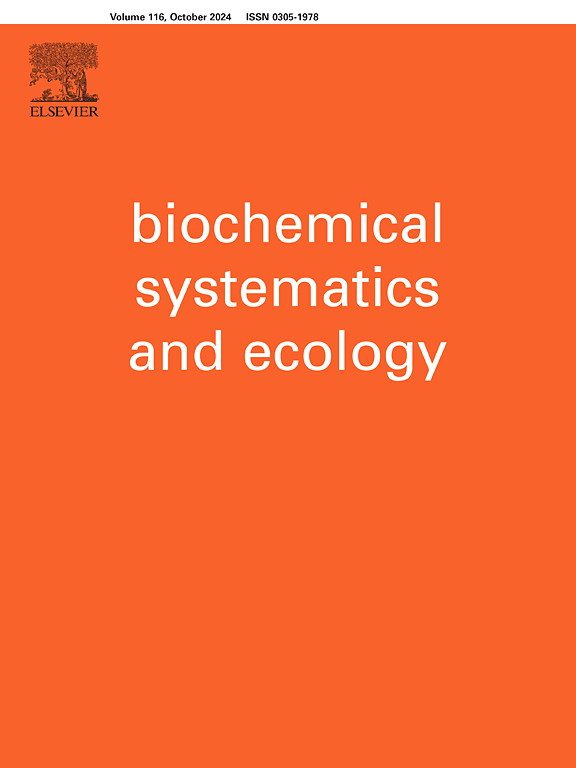Urease inhibitory compounds from the stem bark of Parinari excelsa sabine and their chemophenetic significance
IF 1.4
4区 生物学
Q4 BIOCHEMISTRY & MOLECULAR BIOLOGY
引用次数: 0
Abstract
The chemical study of n-hexane and ethyl acetate soluble fractions from the stem bark of Parinari excelsa led to the isolation of eleven secondary metabolites, including lupane (1, 6, 9 and 10), taraxarane (7 and 11), and fridelane (5) triterpenes, a steroidal glycoside (4) and three phenolic compounds (2, 3 and 8). Their structures were established by spectroscopic techniques (especially 1D and 2D NMR) and high-resolution mass spectrometry, as well as by comparison with literature data. Apart from 3-O-β-d-glucopyranosyl-stigmasta-5,11(12)-diene (4), all these compounds are reported for the first time in the genus Parinari. Compounds 3, 4 and 10 were found to be urease inhibitors with IC50 values ranging from 10.8 to 22.4, while compounds 1 and 5−8 showed moderate activity with IC50 ranging from 49.4 to 62.9 μM. The chemophenetic relevance of the isolates is discussed.

通过对 Parinari excelsa 茎皮正己烷和乙酸乙酯可溶性馏分的化学研究,分离出 11 种次级代谢产物,包括羽扇豆烷(1、6、9 和 10)、taraxarane(7 和 11)和 fridelane(5)三萜类化合物、一种甾体苷类化合物(4)和三种酚类化合物(2、3 和 8)。这些化合物的结构是通过光谱技术(特别是一维和二维核磁共振)和高分辨率质谱分析以及与文献数据的比较确定的。除了 3-O-β-d-glucopyranosyl-stigmasta-5,11(12)-diene (4)之外,所有这些化合物都是 Parinari 属首次报道的。发现化合物 3、4 和 10 是脲酶抑制剂,其 IC50 值在 10.8 到 22.4 之间,而化合物 1 和 5-8 显示出中等活性,IC50 值在 49.4 到 62.9 μM 之间。本文讨论了这些分离物的化学相关性。
本文章由计算机程序翻译,如有差异,请以英文原文为准。
求助全文
约1分钟内获得全文
求助全文
来源期刊

Biochemical Systematics and Ecology
生物-进化生物学
CiteScore
3.00
自引率
12.50%
发文量
147
审稿时长
43 days
期刊介绍:
Biochemical Systematics and Ecology is devoted to the publication of original papers and reviews, both submitted and invited, in two subject areas: I) the application of biochemistry to problems relating to systematic biology of organisms (biochemical systematics); II) the role of biochemistry in interactions between organisms or between an organism and its environment (biochemical ecology).
In the Biochemical Systematics subject area, comparative studies of the distribution of (secondary) metabolites within a wider taxon (e.g. genus or family) are welcome. Comparative studies, encompassing multiple accessions of each of the taxa within their distribution are particularly encouraged. Welcome are also studies combining classical chemosystematic studies (such as comparative HPLC-MS or GC-MS investigations) with (macro-) molecular phylogenetic studies. Studies that involve the comparative use of compounds to help differentiate among species such as adulterants or substitutes that illustrate the applied use of chemosystematics are welcome. In contrast, studies solely employing macromolecular phylogenetic techniques (gene sequences, RAPD studies etc.) will be considered out of scope. Discouraged are manuscripts that report known or new compounds from a single source taxon without addressing a systematic hypothesis. Also considered out of scope are studies using outdated and hard to reproduce macromolecular techniques such as RAPDs in combination with standard chemosystematic techniques such as GC-FID and GC-MS.
 求助内容:
求助内容: 应助结果提醒方式:
应助结果提醒方式:


